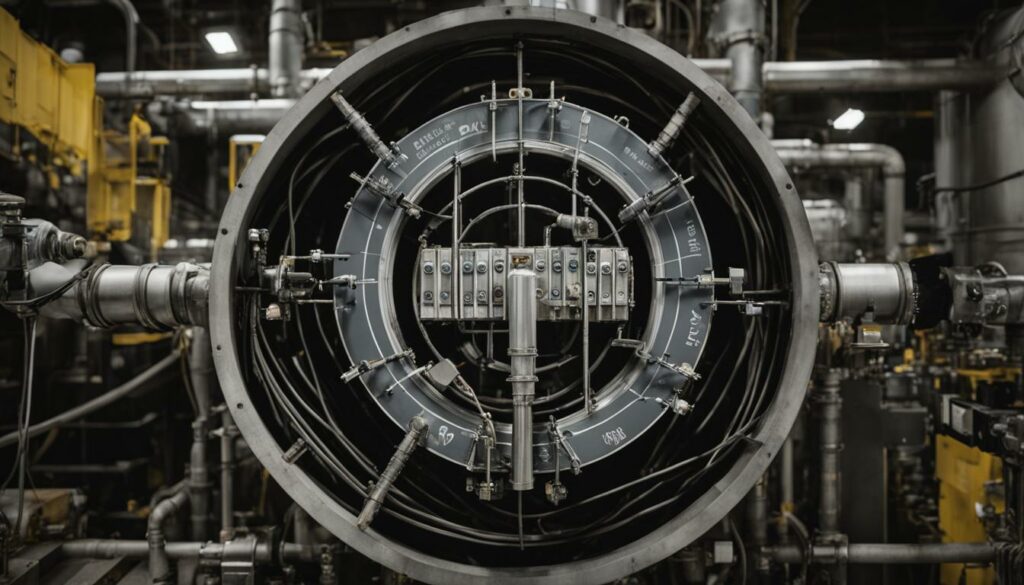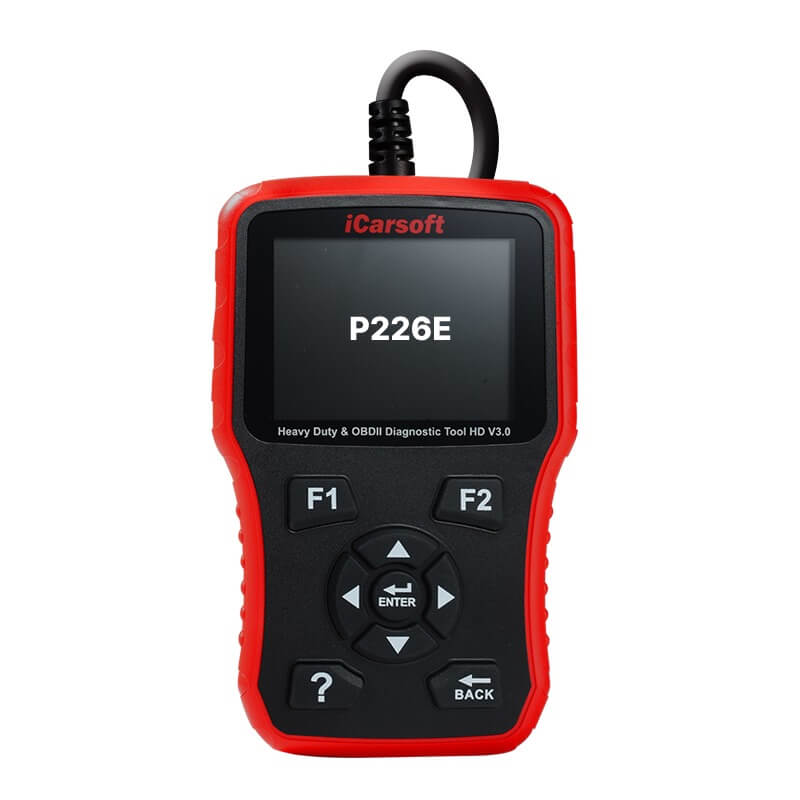P226E – Particulate Trap Reduction Functionality Bank 2
POSTED IN pcodes
Welcome to our article on the P226E diagnostic trouble code (DTC) related to the Particulate Trap Reduction Functionality in Bank 2 of the exhaust system. If you own a vehicle with a diesel engine, understanding this code is essential for proper maintenance and emission control.
The P226E code indicates a malfunction in the Particulate Trap Reduction Functionality, which plays a crucial role in reducing particulate emissions from the exhaust. When this code is triggered, it can affect the overall performance and efficiency of your vehicle.
If you notice the malfunction indicator lamp (MIL) illuminated on your dashboard or experience decreased engine performance, it could be a sign of a P226E code. It is important to address this issue promptly to ensure optimal vehicle operation.
Understanding P226E – Particulate Trap Reduction Functionality Bank 2
The P226E trouble code is a technical description that indicates an issue with the Particulate Trap Reduction Functionality in Bank 2 of the vehicle’s exhaust system. Understanding the meaning, severity, symptoms, common causes, troubleshooting steps, and repair options associated with this code is essential for addressing the problem promptly and effectively.
Technical Description and Meaning
The P226E code specifically points to a malfunction in the Particulate Trap Reduction Functionality in Bank 2 of the exhaust system. Bank 2 refers to the specific side of the engine where the issue is detected. This code signifies a problem related to the vehicle’s emission control system, particularly the reduction of particulate emissions from the exhaust system.
Buy tested tuning file for Adblue / EGR / DPF / Adblue off now!
Severity and Symptoms
The severity of the P226E code varies depending on the specific vehicle and circumstances. However, it is generally considered a moderate to serious issue that requires attention. Some common symptoms of a P226E code include:
- Malfunction indicator lamp (MIL) illuminated on the dashboard
- Decreased engine performance and power
- Increased fuel consumption
- Smoke or unusual exhaust emissions
Common Causes
Several factors can contribute to the triggering of a P226E code. Some common causes include:
- Faulty sensors related to the Particulate Trap Reduction Functionality
- Clogged or damaged particulate filters
- Issues with the exhaust gas recirculation (EGR) system
- Malfunctioning components within the emission control system
Troubleshooting Steps and Repair
When faced with a P226E code, it is important to follow a systematic troubleshooting approach. The following steps may be taken to identify and resolve the issue:
- Inspect and clean or replace sensors and filters associated with the Particulate Trap Reduction Functionality
- Check for any leaks or blockages in the exhaust system
- Verify the proper functioning of the EGR system
- Perform diagnostic tests and clear the trouble code
- If necessary, perform repairs or component replacements to address the specific cause of the P226E code
Keep in mind that specific repair steps may vary depending on the make and model of the vehicle. It is recommended to consult the vehicle’s repair manual or seek professional assistance for accurate diagnosis and repair.
| Severity | Symptoms | Common Causes | Troubleshooting Steps | Repair |
|---|---|---|---|---|
| Moderate to serious | – Malfunction indicator lamp (MIL) illuminated – Decreased engine performance – Increased fuel consumption – Unusual exhaust emissions |
– Faulty sensors – Clogged filters – EGR system issues |
– Inspect and clean or replace sensors and filters – Check for leaks or blockages – Verify proper EGR system function |
– Perform necessary repairs or component replacements |
Common Causes of P226E – Particulate Trap Reduction Functionality Bank 2
When encountering the P226E trouble code related to the Particulate Trap Reduction Functionality in Bank 2 of the exhaust system, it’s essential to identify the common causes behind this issue. Understanding these causes is crucial for effective troubleshooting and repair. Here are some of the common culprits:
- Diesel Particulate Filter (DPF) Issues: A blocked or excessively soot-laden DPF can trigger the P226E code. Over time, the DPF may become clogged, hindering its proper functioning and leading to reduced performance.
- Selective Catalytic Reduction (SCR) System Problems: Malfunctions in the SCR system, which is responsible for reducing nitrogen oxide emissions, can also contribute to the P226E code. Faulty components or a malfunctioning SCR system may compromise emission control, causing the code to appear.
- Exhaust Gas Recirculation (EGR) System Concerns: The EGR system recirculates a portion of the exhaust gases back into the combustion chamber to reduce emissions. Issues such as clogged or leaking EGR valves, malfunctioning sensors, or damaged tubing can trigger the P226E code.
- Related Sensors: Faulty or malfunctioning sensors, such as those monitoring the DPF, SCR, or EGR system, can contribute to the appearance of the P226E code. These sensors play a crucial role in monitoring and regulating emission control, and any inconsistencies can affect the engine’s performance.
To effectively resolve the P226E code, it is important to diagnose and address the specific cause behind it. By understanding these common causes and conducting targeted inspections, you can take the necessary steps to efficiently repair the exhaust system and ensure optimal emission control.
If you need assistance in diagnosing or resolving the P226E code, consult a professional mechanic with expertise in diesel engines and emission control systems. They will be able to provide accurate diagnosis and recommend the appropriate repairs or replacements to rectify the underlying issues.

Comparison of Common Causes for the P226E Code
| Cause | Description |
|---|---|
| Diesel Particulate Filter (DPF) Issues | Blockage or excessive soot accumulation in the DPF |
| Selective Catalytic Reduction (SCR) System Problems | Malfunctions in the SCR system affecting emission control |
| Exhaust Gas Recirculation (EGR) System Concerns | Clogged or leaking EGR valves, malfunctioning sensors, or damaged tubing |
| Related Sensors | Faulty or malfunctioning sensors monitoring emission control systems |
Troubleshooting and Repair for P226E – Particulate Trap Reduction Functionality Bank 2
Troubleshooting and repairing a P226E code related to the Particulate Trap Reduction Functionality in Bank 2 of the exhaust system requires a systematic approach. By following the below steps, you can diagnose and fix the issue effectively.
1. Perform a thorough inspection
Start by inspecting the entire exhaust system, including the diesel particulate filter (DPF), selective catalytic reduction (SCR) system, and exhaust gas recirculation (EGR) system. Look for any blockages, leaks, or damaged components that may be causing the code.
2. Clean or replace sensors and filters
If the inspection reveals faulty sensors or clogged filters, clean or replace them as necessary. These components play a crucial role in the proper functioning of the Particulate Trap Reduction Functionality, so ensuring their cleanliness and functionality is important for resolving the P226E code.
3. Check for software updates or reprogramming
In some cases, a software update or reprogramming of the engine control unit (ECU) may be required to address the P226E code. Check with the vehicle manufacturer or a professional mechanic to determine if any updates are available and if they could resolve the issue.
Expert Tip: Following the manufacturer’s guidelines is essential throughout the troubleshooting and repair process to ensure accurate diagnosis and prevent further complications.
No matter the troubleshooting steps taken, it’s recommended to consult with a professional mechanic for accurate diagnosis and repair. They have the specialized knowledge and tools to tackle the complexities of the exhaust system and diesel engines.

| Troubleshooting Steps for P226E – Particulate Trap Reduction Functionality Bank 2 |
|---|
| Perform a thorough inspection of the exhaust system, including the DPF, SCR, and EGR systems. |
| Clean or replace faulty sensors and filters. |
| Check for software updates or reprogramming of the ECU. |
| Consult with a professional mechanic for accurate diagnosis and repair. |
Conclusion
In conclusion, addressing the P226E diagnostic trouble code (DTC) related to the Particulate Trap Reduction Functionality in Bank 2 of the exhaust system plays a crucial role in maintaining the optimal performance and emission control of your diesel engine vehicle. By understanding the technical description, common causes, and troubleshooting steps associated with this code, you can effectively resolve the issue and ensure the smooth operation of your vehicle.
Seeking professional assistance in diagnosing and repairing the underlying problem is highly recommended. Experienced mechanics can provide accurate diagnosis and determine the best course of action to resolve the P226E code. Additionally, considering permanent removal of the code through ECU file upload options can provide long-term solutions.
Regular vehicle maintenance and inspection of the exhaust system is essential in preventing and addressing diagnostic trouble codes like P226E in a timely manner. By keeping up with routine maintenance tasks such as filter replacements, sensor checks, and regular inspections of the exhaust system, you can minimize the chances of encountering such issues and ensure the reliable operation of your vehicle’s emission control system.
FAQ
What is the P226E trouble code?
The P226E trouble code relates to the Particulate Trap Reduction Functionality in Bank 2 of the exhaust system. It is commonly found in diesel engines and is related to the emission control system.
What does the P226E code mean?
The P226E code indicates a malfunction in the Particulate Trap Reduction Functionality, which is responsible for reducing particulate emissions from the exhaust. It is important to address this code as it can affect the performance and efficiency of the vehicle.
What are the symptoms of a P226E code?
Some symptoms of a P226E code may include a malfunction indicator lamp (MIL) illuminating on the dashboard and decreased performance of the engine.
What are the common causes of a P226E code?
Common causes of a P226E code include faulty sensors, clogged filters, or issues with the exhaust gas recirculation (EGR) system.
How do I troubleshoot and repair a P226E code?
Troubleshooting steps may involve inspecting and cleaning or replacing components, as well as checking for any leaks or blockages in the exhaust system. Repairs may vary depending on the specific cause of the code.


